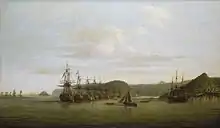HMS Nonsuch (1774)
HMS Nonsuch was a 64-gun third rate ship of the line of the Royal Navy, launched on 17 December 1774 at Plymouth.[2] She was broken up in 1802.
%253B_Nonsuch_(1774)%253B_Vigilant_(1774)%253B_Eagle_(1774)%253B_America_(1777)_RMG_J3624.jpg.webp) Nonsuch | |
| History | |
|---|---|
| Name: | HMS Nonsuch |
| Ordered: | 30 November 1769 |
| Builder: | Plymouth Dockyard |
| Laid down: | January 1772 |
| Launched: | 17 December 1774 |
| Fate: | Broken up, 1802 |
| General characteristics [1][2] | |
| Class and type: | Intrepid-class ship of the line |
| Tons burthen: | 1373 (bm) |
| Length: | 159 ft 5 in (48.6 m) (gundeck);130 ft 10 1⁄2 in (39.9 m) (keel) |
| Beam: | 44 ft 0 7⁄8 in (13.4 m) |
| Depth of hold: | 19 ft 0 1⁄2 in (5.8 m) |
| Propulsion: | Sails |
| Sail plan: | Full-rigged ship |
| Complement: |
|
| Armament: |
|
Career
Nonsuch was commissioned in August 1775 as a guardship at Plymouth. She was fitted for the role in December 1776, but sailed for North America on 23 March 1777.[2]
American War of Independence

On 7 July 1780 Nonsuch, under the command of Sir James Wallace, captured the brig-rigged cutter Hussard of Saint Malo.[4] Hussard was armed with eighteen 6-pounder guns.[5] The Royal Navy took her into service as HMS Echo.
On 14 July Nonsuch captured the 26-gun frigate Belle Poule off the Loire. The Royal Navy took Belle Poule into service under her existing name.
In April 1781, Nonsuch was part of Admiral George Darby's relief fleet during the Great Siege of Gibraltar. On 14 May 1781, on the homeward voyage, while scouting ahead, Nonsuch chased and brought to action the French 74-gun Actif, hoping to detain her until some others of the fleet came up. However, Actif was able to repulse Nonsuch, causing her to suffer 26 men killed and 64 wounded, and continued on to Brest.
Nonsuch was fourth in line attacking the French fleet at the Battle of the Saintes on 12 April 1782) under command of Captain Truscott.[6]
Late in 1782 Nonsuch and Zebra escorted a fleet from Georgia "with the principal inhabitants, their Negroes, and their Effects" to Jamaica.[7]
Floating battery
Between February and May 1794 Nonsuch was at Chatham, being cut down and fitted as a floating battery. Captain Bill Douglas commissioned her in March. In June she was at Jersey under Captain Philippe d'Auvergne, Prince of Bouillon, and Senior Officer of Gunboats, in charge of a small flotilla of useless gunvessels, including Eagle, Lion, Repulse, Scorpion, and Tiger. (The Navy disposed of most of them within a year or so.) Nonsuch was paid off in December. In February 1795 Captain William Mitchell recommissioned her in the Humber at Hull as a floating battery.
Mitchell's successor, in August, was Captain Henry Blackwood. Nonsuch's logs state she arrived in the Humber at the end of June 1795, having sailed up from Chatham under Blackwood's command. By 2 July she was in a permanent mooring at Hull Roads.[3]
In April 1796 Captain Robert Dudley Oliver replaced Blackwood, only to be replaced in October 1797 by Captain Isaac Woolley, who commanded her until 1799.
Fate
In 1802 Nonsuch was broken up.[2]
Citations and references
Citations
- Lavery, Ships of the Line, vol. 1, p. 181.
- Winfield (2008), p.97.
- ADM 52/3258 National Archives (United Kingdom): Captain and Sailing Master's logs.
- "No. 12140". The London Gazette. 28 November 1780. p. 6.
- Demerliac (1996), p.88, #581.
- Famous Fighters of the Fleet, Edward Fraser, 1904, p.106
- Lloyd's List, no. 1415, - accessed 17 June 2014.
References
- Demerliac, Alain (1996) La Marine De Louis XVI: Nomenclature Des Navires Français De 1774 À 1792. (Nice: Éditions OMEGA). ISBN 2-906381-23-3
- Lavery, Brian (2003) The Ship of the Line - Volume 1: The development of the battlefleet 1650-1850. Conway Maritime Press. ISBN 0-85177-252-8.
- Winfield, Rif (2008). British Warships in the Age of Sail 1793–1817: Design, Construction, Careers and Fates. Seaforth. ISBN 978-1861762467.